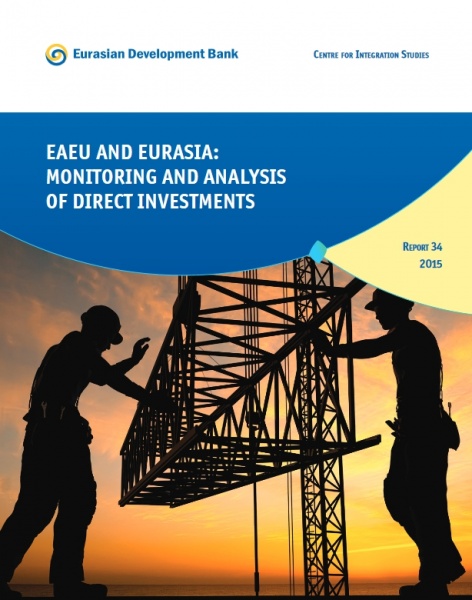EAEU and Eurasia: Monitoring and Analysis of Direct Investments

-
Report
PDF, 5.35 Mb -
Presentation
PDF, 1,002.21 Kb
The report presents new results of the permanent annual project dedicated to monitoring of direct investments in Eurasia. This report focuses on direct investments of Russia, Belarus, Kazakhstan, Armenia, Kyrgyzstan, Tajikistan, and Ukraine in all countries of Eurasia outside the CIS and Georgia as well as reciprocal direct investments of Austria, Netherlands, Turkey, Iran, India, Vietnam, China, the Republic of Korea, and Japan in the seven CIS countries mentioned above.
According to the new report the amount of outgoing direct investments by companies from the EAEU countries grew progressively until 2013 inclusively, but now it is in stagnation. Between 2008 and 2014, FDI stock from the EAEU countries in Eurasia increased by $38 billion and amounted for $71 billion. EAEU companies concentrate their key FDI in European countries.
The EU countries are the main recipients of Russian FDI. In 2014, they accounted for almost 58% of Russian FDI stock in countries of Eurasia outside the CIS and Georgia. At the same time, Russian direct investors enhanced their presence in European countries by over 9%. The Russian capital is highly visible in Iraq, Bangladesh, Serbia, Democratic People's Republic of Korea, Estonia, Latvia, Bosnia and Herzegovina, Bulgaria, Turkey, and Pakistan.
Oil and gas companies continue to remain leaders among Russian TNCs in terms of FDI stock in countries of Eurasia outside the CIS and Georgia. LUKOIL is the largest investor. The top ten exporters of capital also include Gazprom, Rosneft, and Zarubezhneft. Overall, in 2014 the oil and gas sector accounted for 31.6% of Russian FDI stock in the region. Other sectors, which received significant Russian FDI, are telecommunications (21%), finance (13%), and transportation (7%).
According to monitoring data, the amount of Kazakh FDI stock in countries of Eurasia outside the CIS was growing steadily and reached $5.5 billion by the end of 2014. The main destination of Kazakh FDI were the EU countries. Kazakhstan's key sector of international specialization is oil and gas sector. As at the end of 2014, it accounted for approximately 60% of Kazakh FDI stock in countries of Eurasia outside the CIS and Georgia. The second most important sector is wholesale and retail trade (33%), followed by the finance sector (6%).
Armenian, Belarusian and Kyrgyz companies have few projects with FDI in countries of Eurasia and they are insignificant in terms of their value. The reason for this is that these EAEU economies lack major companies with competitive advantages that would make it possible to break into the markets of non-CIS countries.
What about the incoming FDIs to the EAEU? In the same period, the surveyed countries that invest in the EAEU (Austria, the Netherlands, Turkey, China, Iran, India, Vietnam, the Republic of Korea, and Japan) increased their FDI stock in EAEU countries to $82.8 billion.
Asian FDI in the EAEU region continues to grow: as at the end of 2014, FDI of Turkey, China, Iran, India, Vietnam, the Republic of Korea, and Japan reached $44 billion. The most attractive sectors for them at the moment are hydrocarbon production and transportation. At the same time, significant amounts are channelled into mechanical engineering, construction, and finance.
Chinese investors show the strongest dynamics of foreign direct investment (FDI) in the EAEU countries. Between 2008 and 2014, China's FDI stock in the region more than doubled, from $11 billion to $27.1 billion. Japanese FDI reached $14.7 billion, and South Korean FDI reached $1.9 billion.
The data on FDI in the EAEU countries suggest that Chinese FDI is primarily concentrated in Kazakhstan, and Japanese in Russia.
Iran continues to increase its investments in the EAEU countries at low, yet stable rates. The main recipient of its FDI is Belarus (commercial construction and development). The prevailing sector in the sectoral breakdown of Iran's FDI in the EAEU countries is construction, followed by infrastructure networks and transportation. According to the EDB Centre for Integration Studies, Iranian FDI stock in the surveyed post-Soviet countries is more than 90 times higher than counter-investment in Iran ($966 billion vs. $10 million). The main reason for low EAEU FDI in this country is Iran's lack of favorable business conditions.
As distinct from investments by East Asian countries and Iran, Turkish FDI in EAEU countries is distributed by sectors more uniformly. It is represented across all aggregated sectors, except non-ferrous metals and oil and gas sector. Geographical diversification is also observed in most sectors. Turkish FDI stock in the EAEU region as at the beginning of 2015 totalled $7.9 billion. Russia's share in Turkish FDI in EAEU was 72.5%, Belarus' 13%, and Kazakhstan's 10.8%.
Indian FDI in EAEU is distributed between two countries only: Russia ($3.6 billion), and Kazakhstan (US $2.3 billion). Other EAEU economies are of low interest to Indian TNCs for the time being. Two sectors – ferrous metals (FDI in Kazakhstan) and oil and gas sector (primarily, through ONGC's participation in Sakhalin-1 project) – dominate in the sectoral breakdown.
Despite low growth rates in the global economy, as well as volatility and uncertainty in financial markets, the investment expansion by Asian countries in the EAEU economies has not suspended. The experts of the EDB Centre for Integration Studies believe that Asian FDI in EAEU countries will continue to grow. The main role will be played by Chinese investors, which try to give effect to memoranda and preliminary agreements entered into in 2014-2015 and thereby to increase their expansion in a wide range of directions. Japanese companies will try to occupy free niches in Central Asia, where competition among transnational corporations is still low. Iranian investors will continue to strengthen their investments.
EDB researchers suggest that the data, analysis and conclusions presented in EAEU and Eurasia: Monitoring and Analysis of Direct Investments will help companies to better understand the Eurasian business environment and the states to promote corporate integration in order to improve competitiveness of the national economies.
